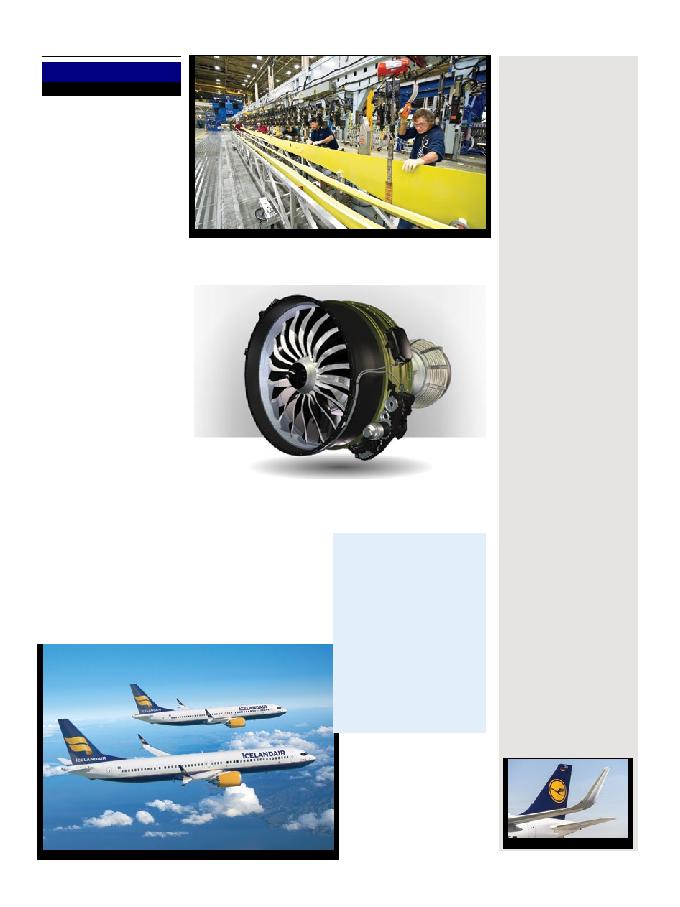
6
GA
/ Vol. 5 / No.4 / APRIL 2013
Boeing is now building the first Next-Generation 737 at the rate of 38 airplanes per
month. Over the past two years, production of the 737 has risen more than 20 percent,
from 31.5 to 38 airplanes a month. Pictured here, mechanics load initial parts of
the spars for the first airplane at the new rate into a spar-assembly machine.
Airline Industry
On February 13, 2013 Boeing and
Icelandair announced a firm order for
16 737 MAX airplanes valued at more
than $1.6 billion at list prices. The order,
originally announced as a commitment for
12 airplanes in December 2012, has been
increased to 16 airplanes and includes
737 MAX 8s and 9s, as well as purchase
rights for eight additional 737 MAXs.
Shown here is an artist rendition of the
MAX 8 and MAX 9 in Icelandair livery.
Breakthrough
Performance advancements are driven
by appropriate application of new
technology throughout an engine.
Success in development of new tech-
nology requires the combination of
both consistent investment and oppor-
tunities for commercial application.
Two engine families have
contributed significantly to the design
of the LEAP engine, the CFM56 and
the GE90/GEnx series of engines.
The GE90/GEnx contributed the
high-efficiency core architecture
to minimize fuel consumption,
while the CFM56 legacy drove
reliability and maintenance cost
design practices. At entry into
service in 2017, it is estimated that
the GE90/GEnx architecture will
have generated 80 million flight
hours of revenue service, while the
CFM56 family will have over 700
million flight hours of experience.
The LEAP engine family offers
proven, material advantages over
any other engine, with 550,000 hours
of proven experience with 99.98%
reliability, and 22,000 engines
delivered on-time and on-spec.
The CFM LEAP pedigree ensures
with confidence the ability to deliver
a 15% improvement in fuel efficiency,
as compared to the CFM56-7BE,
while maintaining the same level
of dispatch reliability and life-cycle
maintenance costs as the CFM56-
7BE. With its simple architecture
and $2 billion annual investment in
technology, the LEAP engine family
LEAP
Turbofan Engine
Leap-1A 24,500 32,900 pounds thrust
Leap-1B 20,000 28,000 pounds thrust
Leap-1C 27,980 30,000 pounds thrust
The CFM LEAP-1B is the exclusive powerplant for the Boeing 737 MAX family
of single-aisle aircraft (737 MAX-7, 737 MAX-8, 737 MAX-9). This engine has
been optimized to provide the 737 MAX the best possible fuel efficiency while
maintaining the reliability and maintenance cost legacy of the CFM56 family.
Did you know?
· LEAP's angled high-pressure turbine
blade tip squealer generates an aerody-
namic vena contracta to reduce leakage
and improve turbine efficiency.
· LEAP's high-pressure turbine blade coun-
ter tip baffle airfoil reduces aerodynamic
loss in the turbine and improves engine
fuel burn. LEAP's non axi-symmetric
airfoil bands and platforms limit secondary
flow to reduce pressure loss and improve
engine fuel burn.
· LEAP's nested ball/roller for core bearing
spring finger reduces sump volume
and increases engine by-pass ratio.
· LEAP's high-pressure compressor airfoil
design with rotor radial camber distribu-
tion improves compressor stage throttle
margin.
offers the lowest cost and highest
revenue-generating ability, saving an
estimated nearly $3 million per plane.
This is CFM, proven
performance, low execution
risk, and the application of
advanced technology both at
entry into service and throughout
an engine's life cycle. ·
Boeing subsidiary
unveils tool to
improve testing of
wireless networks
Boeing, a subsidiary Digital
Receiver Technology Inc. (DRT)
debuted an easier, faster way for
wireless carriers and infrastructure
providers to assess their cellular
network and identify areas where
upgrades may be required.
Unveiled during the 2013
Mobile World Congress in
Barcelona, the pocket-sized
DRT4311B could ultimately help
increase network performance
and customer satisfaction.
"The unit's Software Defined
Radio architecture and wideband
receiver allow operators to use
the same device to measure
multiple frequency bands
without changing hardware
increasing their productivity and
reducing cost. The platform's
low power consumption and
lightweight design make it
even more affordable and
adaptable according to DRT.
The DRT4311B can
simultaneously scan between
2G, 3G and 4G networks
with a wireless control
application that is compatible
with any Android device. ·
Lufthansa takes
delivery of it first
Airbus A320 equipped
with Sharklets
Lufthansa has taken delivery
of its first A320 equipped with
Sharklets at the Airbus site in
Hamburg, Germany. Lufthansa
is became the first carrier in
Europe to take advantage of the
new fuel-saving wing-tip devices.
The airline will receive 21 more
A320 Family aircraft equipped
with Sharklets until 2015.
Sharklets are made from
light-weight composites and are
2.4 meters tall. They are an option
on new-build A320 Family aircraft
and standard on all members of
the new A320neo family. They
offer operators up to four percent
fuelburn reduction on longer range
sectors and provide the flexibility
of either adding an additional
100 nautical miles range or
increased payload capability
of up to 450 kilograms. ·

